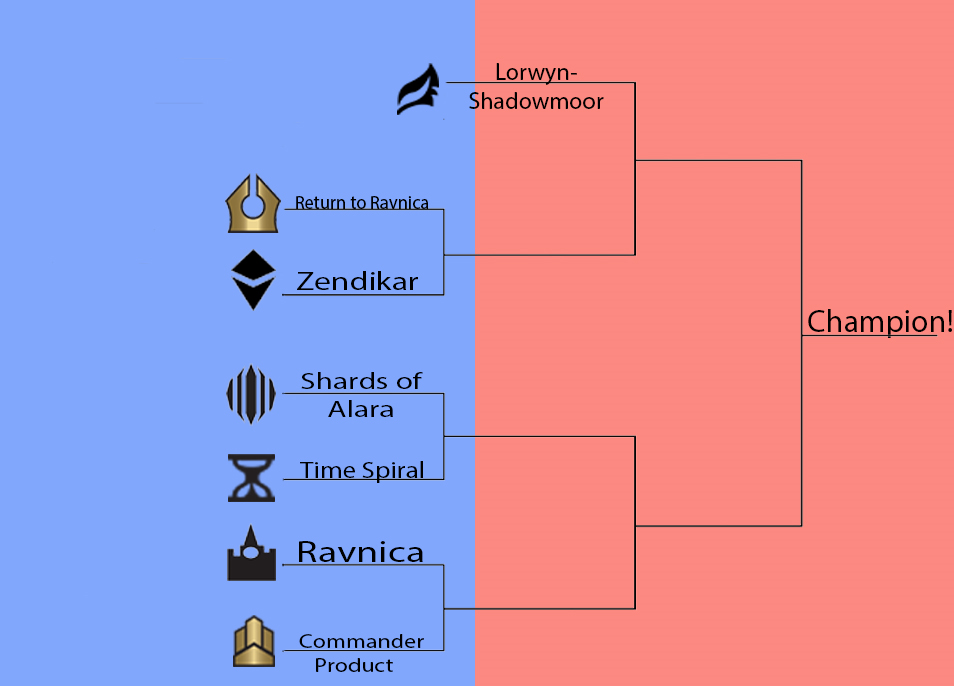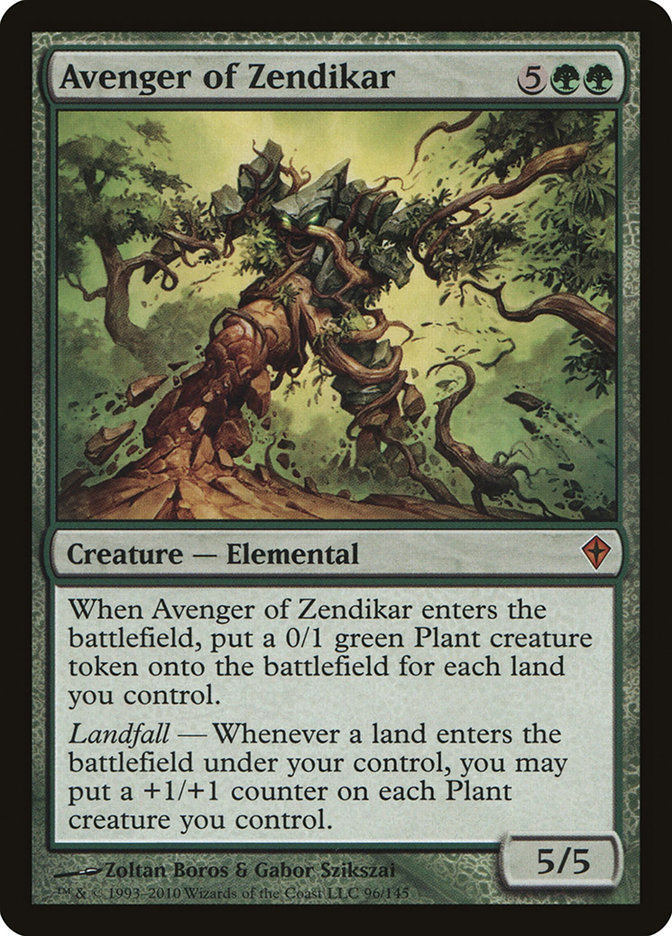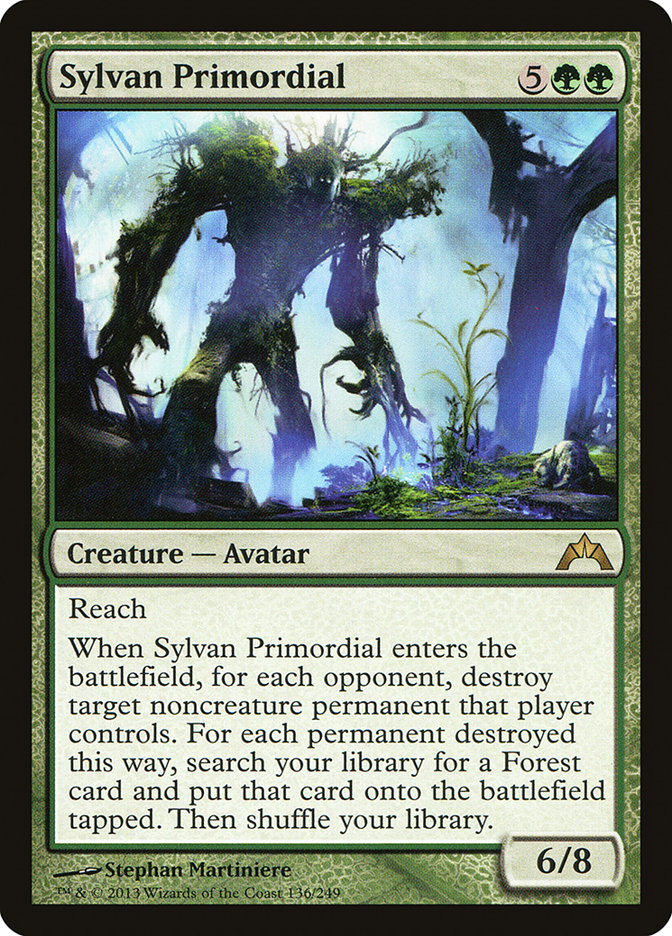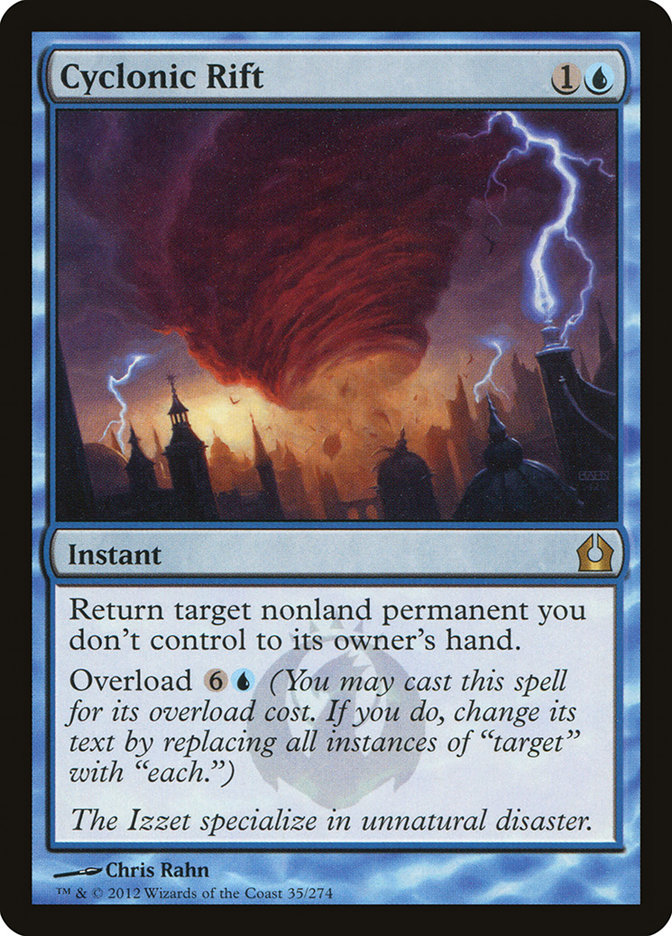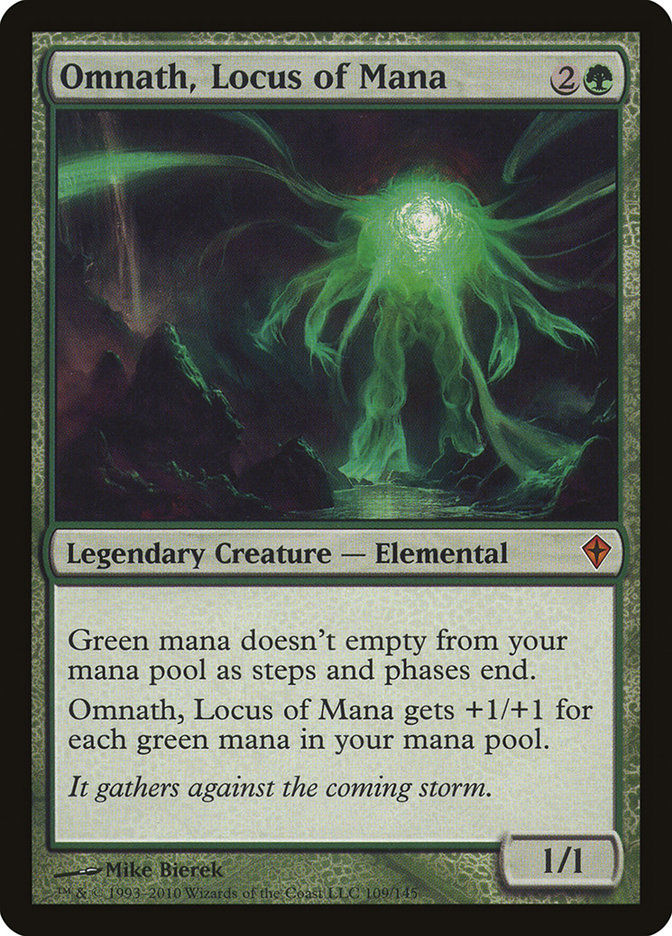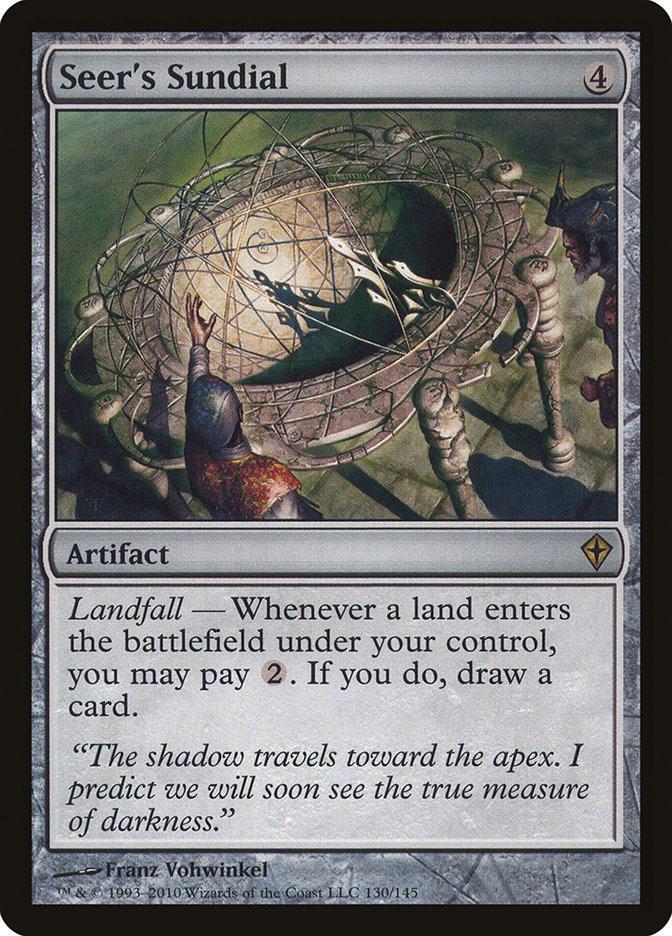This round of Battle Of The Blocks is a Modern matchup pitting the land-loving Zendikar block against the multicolored Return to Ravnica block. A thunderous roar of applause and adulation greeted the homecoming to the beloved plane of Ravnica once Return to Ravnica was announced. The original Ravnica block’s guild theme and amazing Limited format were favorites among players who had survived the cold Affinity winter and maligned Kamigawa Draft season, leaving Return to Ravnica block Andre the Giant-sized boots to fill.
Return to Ravnica block diced up the original guild order, deciding to separate the ten guilds between the first two sets, Return to Ravnica and Gatecrash, and then creating a ten-man tag-team match in the final set of Dragon’s Maze, with all ten guilds coming together in a puree of the five colors of Magic. Return to Ravnica coasted through its earlier matches on the back of the ten guild mechanics and strong legendary creatures and looks to take down Zendikar just like its other competitors with a wild smash of Borborygmos’ hammer.
Zendikar block germinated as a combination of two simple ideas—a block that embraces the adventuring feel of movies like Indiana Jones and a focus on the most important card type in the game: lands. The adventuring theme was fleshed out with an accompaniment of Traps, Quests, and adventuring parties to help players explore the floating Zendikons, fight land hungry ogres, and explore cavernous tombs to find hidden treasures and buried secrets. For Commander, the land theme is where Zendikar shines, bringing the quintet of enemy fetch lands and other important land-focused spells like Oracle of Mul Daya and Avenger of Zendikar to kitchen tables everywhere.
The third set defied the common large-small-small format of previous blocks and heralded the plus-sized Rise of the Eldrazi set, which brought new mechanics and new beings to Magic. Emrakul, the Aeons Torn and friends descended on the Commander format with an unrivaled ferocity, demolishing playgroups left and right with the annihilator mechanic and the abundance of fast mana in the format. For this week’s Battle of the Blocks, this heavy weight contender will need to bring more than some pretty lands to crush the electrifying Return to Ravnica.
Before we begin, let’s check the bracket to see how far we’ve progressed:
What a Top 8 we have! Remember, these battles are to decide which block contributed the most to Commander, not the best block in all of Magic. They will be compared in the usual five categories: Staples, Commanders, Strategies, Flavor, and The Bad.
Staples
Five Notable Staples From Zendikar block
1) Enemy Color Fetch Lands
2) Oracle of Mul Daya
3) Stoneforge Mystic
4) Day of Judgment
5) Avenger of Zendikar
Making its name known at the PAX Party, Arid Mesa was one of the first cards spoiled from Zendikar block, concluding the cycle of fetch lands started back in 2002 via Onslaught. The fetch lands have been stalwarts of the Commander format for people that can afford them because of the low cost these lands require to make even the greediest mana bases perform at their very best. These new fetches found their home in a block that loved multiple lands coming into play on the same turn due to the landfall mechanic that is conveniently featured on our #5 card:
Avenger is the mythic that sees the most play from Worldwake, even over face of the company Jace, the Mind Sculptor, because of its ability to make a myriad of Plants and win games on the spot with cross format all-star Craterhoof Behemoth. The ability to drop multiple lands a turn is so powerful that four-drop 2/2 Oracle of Mul Daya has seen large amounts of play as another way to drop more lands on the battlefield while sculpting the spells you draw.
Five Notable Staples From Return To Ravnica Block
1) Sylvan Primordial
2) Chromatic Lantern
3) Cyclonic Rift
4) Supreme Verdict
5) Guildgates, Keyrunes, Cluestones
Keeping on the mana-fixing theme from Zendikar, our #5 slot brings low-price color fixing to players who want to reliably cast their spells without spending twenty dollars per nonbasic land. Chromatic Lantern also fits this "low price, great fixing" theme by turning each land into a Command Tower and ramping the player ahead a turn.
Two of the strongest cards in the format, Sylvan Primordial and Cyclonic Rift, call Return to Ravnica block home. Neither of these cards deserves a ban, but their power within the format is undeniable. Cyclonic Rift is great at ending the game by bouncing the opponent’s board, leading to Commander players around the world forcing this instant-speed Devastation Tide for opponents into every blue deck they own.
Sylvan Primordial’s greatest comparison is the banned Primeval Titan, as both put a surplus of lands into play and both love to enter the battlefield as many times as possible. The main difference and why Sylvan Primordial won’t get banned is that a Sylvan Primordial is only good in a deck that actually contains Forests. The offensive Primeval Titan, when copied, stolen, or even when attacking, could grab any land like Cabal Coffers and Urborg, Tomb of Yawgmoth, making it a much worse card to play against than Sylvan Primordial.
Cards To Consider
Mono-red Commander decks have a distinct problem in keeping up with decks that ramp or draw an immense amount of cards, so they are forced to play more aggressive to win before controlling decks can take over the game. Chandra Ablaze, the diva of Conley Woods’ heart, may be the answer for mono-red to even the playing field with the draw-go decks that are so common in Commander, with a -2 that brings each player’s hand into equality and ruins any long-term game plan combined with a +1 that easily gets rid of opponents’ planeswalkers.
The fuse spells from Dragon’s Maze haven’t made a great impact on the format yet, but Flesh // Blood has the capability to go from a mid-card player to an all-star. The scavenge effect on Flesh is decent, but the second half of this fuse spell, Blood, is where the card ramps up in power. This card is truly better as the sum of its parts and should soon be an auto-include in most Jund builds.
Verdict: This is insanely close, as both of these blocks contributed so much to the Commander format and match up so well in this section that a clear winner is hard to discern. In the current state of the format, I have to give it to Return to Ravnica because of the prevalence of both Cyclonic Rift and Sylvan Primordial.
Commanders
Return to Ravnica block introduced twenty new legends to the Commander format, with each defining an aspect of their respective dual-colored guild. Unlike previous blocks like Magic 2010-2014 or the Commander product, these legends have benefited from the strict flavor of the block and turned the lore of the plane of Ravnica into unique creations that have a defined impact on any board. This adherence to the flavor of the block forced Magic R&D to create specialized generals that possess the qualities of their guilds and slot perfectly into specific deck archetypes.
Melek, Izzet Paragon is perfect for any spell-crazed U/R deck; Ruric Thar, the Unbowed is an amazing aggressive Gruul general; and Trostani, Selesnya’s Voice has almost usurped the position of the best G/W token general in the Commander format. These Return to Ravnica generals are still making an impact on Commander and will not be sent down to the minor leagues for a long time.
We’ve come to the part of the series where I get to be blunt about these blocks, and Zendikar vastly underperforms in this section compared to the rest of the Top 8. The legends that it brought to the format that see consistent play are:
That’s it.
Some people play Thada Adel in either an interesting Voltron shell or as an evasive blue artifact deck, but these builds show up once in a blue moon. The greatest impact that Zendikar block has had on the landscape of Commander are the nonartifact colorless legends of Ulamog, the Infinite Gyre and Kozilek, Butcher of Truth. These decks are usually interesting conglomerates of fast mana, multiple sweeper effects, and complicated mana bases that are met with revulsion and moderate win rates. The legendary Eldrazi are an interesting area for players to explore, but their annihilator mechanic combined with the incredible difficulty to remove have stricken these decks with a black mark, leading to them being hated out of most tables.
Verdict: Return to Ravnica once again shines in this section with its set of twenty legends that see heavy to moderate play in Commander.
Strategies
It’s pretty easy to put two and two together here. Zendikar block catapulted land ramp and land-based strategies leagues ahead with its printing. Cards like Oracle of Mul Daya, Growth Spasm, Realms Uncharted, and Seer’s Sundial are important parts of any deck that wants to intensely focus on lands to get ahead. To top this off, Rampaging Baloths and Avenger of Zendikar each fit into land ramp and tokens strategies, both of which get a helping hand from Zendikar block.
Some great anthem effects come from this block like Oran-Rief, the Vastwood; Beastmaster Ascension; and Eldrazi Monument, which can be linked together with token producers like the rebounding Nomads’ Assembly or the mana-hungry Conqueror’s Pledge. Zendikar block played host to a couple of tribes; Warren Instigator and Tuktuk Scrapper are solid inclusions in a Goblin deck, Nissa Revane and Joraga Warcaller help Elf decks increase their consistency, and the Vampire tribe grabbed Malakir Bloodwitch and Kalastria Highborn. The final gift that Commander was given from Zendikar block is the fun Ally tribe that pops up as a RUG or five-color tribal concoction that brings a smile to anyone that plays it.
The focusing of a single strategy through each guild means that multiple different decks found their true nature in Return to Ravnica block. Graveyard-based decks turned to the Golgari and Dimir to put more cards into the graveyard with Jarad’s Orders and Grisly Salvage or the grind sub-mechanic on cards like Consuming Aberration and Undercity Informer. Any deck that wanted to gain life found the perfect method to do so in the extort mechanic from the Orzhov that pumped extra mana through cards like Pontiff of Blight, Treasury Thrull, and Blind Obedience.
The Selesnya guild provided two important things for the popular token decks: a way to make tokens and a way to duplicate them. In Dragon’s Maze, the Selesnya guild symbol graced token makers like Trostani’s Summoner and Advent of the Wurm, while Return to Ravnica provided a way to duplicate these huge tokens with the populate mechanic on impactful cards like Trostani, Selesnya’s Voice and Vitu-Ghazi Guildmage.
Verdict: The focused guild archetypes led to a bevy of great cards printed for a variety of different deck strategies, allowing Return to Ravnica block to once again overwhelm Zendikar block and win this section.
Flavor
The flavor of Zendikar was amazingly well done. The block is set on a plane covered in floating land masses and smothered in vines and old temples fit for a venturing band of allies to explore and find the inner secrets of while avoiding traps at every turn. The Quests actually see play in Commander, with Luminarch Ascension, Beastmaster Ascension and Bloodchief Ascension each telling the story of an explorer learning the skills necessary to ascend to a new form and being enchantments that are must-deal-with threats. Zendikar and Worldwake contained questions that players wanted answers to as small hints were dropped of the coming craziness in Rise of the Eldrazi, with cards like Eldrazi Monument and Eye of Ugin giving subtle clues as to the progression of the story.
When Kozilek, Butcher of Truth first burst out of the mothership as a spoiler, people were shocked and excited to see where the story of the block was progressing and what new insanity would be unleashed. That’s what is so great about the entire Zendikar block from a flavor standpoint—it told a story in the background while never sacrificing card design or quality. Cards like Squee’s Toy or Gerrard’s Wisdom with story-driven flavor text weren’t used in Zendikar block to hold the player’s hand and force them to recognize the plotline. Instead, small hints and gentle nudges let people discover for themselves what eldritch monsters were about to be released on the plane of Zendikar.
Magic players finally found a way to relate to the distinct allied- and enemy-colored pairings in the original Ravnica block and now the newer Return to Ravnica block through the guild system. During the Prerelease, it was common to hear people claim allegiance to a specific guild as their sealed sets were delivered, and this binding of the player to a guild continued as the block progressed. From the Guildmages to the Cluestones to the legends, everything was about the guilds, but little was about an actual story.
What was the point of Return to Ravnica block? Most players can figure out that there is a maze involved somehow in this whirling maelstrom of guild sovereignty, but it’s barely even pointed out what they are searching for or if it’s even achieved. Return to Ravnica, just like Ravnica block before it, does a great job establishing an identity for the color pairs but an abysmal job communicating why we came back to the plane in the first place.
Verdict: Zendikar block receives high marks for its expert storytelling and flavorful card design, blazing past the guild-loving Return to Ravnica block.
The Bad
Emrakul, the Aeons Torn was a controversial ban at the time, with a contingent of players claiming that it didn’t harm the format due to its high mana cost and relative ease to deal with when played against correctly. The other side of players repeatedly pointed to cards like Tooth and Nail, Defense of the Heart, and Mana Reflection, forcing this fifteen-mana Eldrazi to eat something it didn’t have protection from: the ban hammer. Although both Sylvan Primordial and Cyclonic Rift are causing some agitation in the current Commander community, neither is currently banned, but the constant frustration that players convey about these cards necessitates their mention here.
Verdict: Return to Ravnica block skates by in this battle by never dealing the low blow to the format that Emrakul, the Aeons Torn did.
Final Verdict
This battle was pretty close, with Zendikar and Return to Ravnica pretty much splitting the first section and then Zendikar winning the flavor section. But the overwhelming victories by Return to Ravnica block in the Strategies section and Commanders section means it wins this edition of Battle of the Blocks. For a quick summation, here’s a handy report card I whipped up about each block’s contribution to the Commander format.
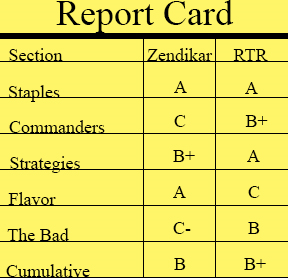
Just like that Return to Ravnica block advances to duke it out against Lorwyn-Shadowmoor block in the Final Four! Next round will feature nostalgia favorite Time Spiral block going face-to-face with another multicolored block in Shards of Alara. Don’t miss it!

